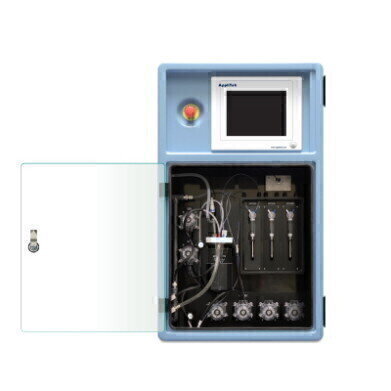Analytical Instrumentation
On-line analysis of caustic scrubbers: tight control, considerable savings
May 20 2015
Caustic scrubbers are key in achieving tight specifications of ethylene and propylene end products, and necessitate close attention to optimal operation. AppliTek’s field-tested EZ-Caustic® on-line analyser system is capable of lowering significantly the process set point of the scrubber, down to a typical level of 0.5%wt in weak caustic. On-line measurement of sodium hydroxide and other critical alkali parameters is assured, allowing operators to take faster and more decisive actions in the process.
In today’s competitive markets, manufacturers are examining every aspect of their operations to find better ways to enhance productivity and lower costs. Cutting down on considerable consumption of commodity chemicals such as sodium hydroxide used in caustic scrubbers is the quintessential example for refining and ethylene plants, especially in traditional one-stage scrubber designs.
The caustic wash tower or 'scrubber' 'wet scrubber' is a large-scale treatment unit that performs a continuous wash by spraying an incoming gas stream with a caustic absorption liquid. Caustic scrubbing is used in refineries to purify straight-run light hydrocarbons, middle distillates and feed streams to isomerization and polymerization units. Another important field of application is in olefin (ethylene) production where thermal cracking processes inevitably introduce a number of byproducts including acid gases hydrogen sulphide (H2S) and carbon dioxide (CO2) that need to be removed.
Caustic scrubbers involve a necessary yet costly purification step in order to achieve final end product quality with tight specifications. Optimal operation and performance of these treatment units will determine whether products are commercially viable or not. Although caustic scrubbers can achieve high removal efficiencies for acid gases, their efficiency can be compromised by common practices to measure and control the caustic strength. Sometimes high amounts of caustic are absolutely necessary to achieve the optimal absorption rates, but too often fresh caustic is unnecessarily added, leading to excess use of caustic.
Traditionally, pH monitoring is used to control caustic scrubbers, combined with laboratory measurements of the solution at scrubber outlet. The actual frequency of the laboratory measurements is depending on the company’s standard operating procedures requiring the outlet to be sampled and analysed x times a day.
In contrast, AppliTek’s proprietary on-line analyser system EZ-Caustic® was developed to monitor and control the scrubber performance by determination of all critical alkali process parameters. EZ-Caustic® samples automatically the outlet and monitors continuously levels of sodium hydroxide (NaOH), sodium carbonate (Na2CO3) and sodium sulphide (Na2S). An ex-proof sampling and preconditioning system specifically built for this application allows to automatically sample the outlet, compensating for the extreme sample conditions and the presence of polymeric constituents. The simultaneous measurement of all critical parameters allows a superior control of the scrubber’s operation and specific absorption rates, resulting in considerable savings and a fast return on investment.
Field experience obtained with the EZ-Caustic® has shown that tight control and optimal operation of a caustic scrubber is within reach of every operator of caustic scrubbers. At the moment of writing the analyser system has been field-tested for more than 20 years in an ethylene plant, allowing the process set point to be lowered from 3% towards typically 0.5%wt in the intermediate and weak caustic stages. Upon benchmarking with other on-line monitoring techniques, such as spectroscopy, the EZ-Caustic® demonstrated superior performance and reliability, including an up-time of more than 98%.
Click here to download the white paper.
For further information please visit the website.
Digital Edition
PIN 25.1 Feb/March
March 2024
In This Edition Safety - The technology behind the ION Science Tiger XT - Safety with ammonia and LOHCs as hydrogen carriers Analytical Instrumentation - Discussion on new tribology te...
View all digital editions
Events
Apr 28 2024 Montreal, Quebec, Canada
Apr 30 2024 Birmingham, UK
May 03 2024 Seoul, South Korea
May 05 2024 Seville, Spain
May 06 2024 Riyadh, Saudi Arabia


















